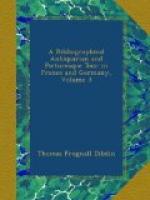The monastery, however, only contains twelve Religieux. The interior
of the church is covered with such a profusion of gilt and rich
ornaments, that when the sun shines full upon it, it is difficult to
view it without being dazzled.” Page 79.
The old monastery of Moelk
successfully stood a siege of three months,
against the Hungarians, in
the year 1619. See Germ. Austriaca,
&c. p. 18.
[106] [The Abbe Strattman SURVIVED the above interview
only about five
years. I hope and
trust that the worthy Vice Principal is as well
NOW, as he was about three
years ago, when my excellent friend Mr.
Lodge, the Librarian of the
University of Cambridge, read to him an
off-hand German version of
the whole of this account of my visit to
his Monastery.]
[107] This history has come down to us from well authenticated
materials;
however, in the course of
its transmission, it may have been partially
coloured with fables and absurdities.
The Founder of the Monastery was
ALTMANN, Bishop of Passau;
who died in the year 1091, about twenty
years after the foundation
of the building. The two ancient
biographies of the Founder,
each by a Monk or Principal of the
monastery, are introduced
into the collection of Austrian historians
by Pez; vol. i. col.
112-162. Stengelius has a bird’s eye view
of the monastery as it appeared
in 1638, and before the principal
suite of apartments was built.
But it is yet in an unfinished state;
as the view of it from the
copper-plate engraving, at page 248 ante,
represents it with the intended
additions and improvements.
These latter, in all probability,
will never be carried into effect.
This monastery enjoyed, of
old, great privileges and revenues. It had
twenty-two parish churches—four
towns—several villages, &c. subject
to its ecclesiastical jurisdiction;
and these parishes, together with
the monastery itself, were
not under the visitation of the Diocesan
(of Passau) but of the Pope
himself. Stengelius
(Monasteriologia, sign.
C) speaks of the magnificent views seen
from the summit of the monastery,
on a clear day; observing, however,
(even in his time) that it
was without springs or wells, and that it
received the rain water in
leaden cisterns. “Caeterum (adds he)
am[oen]issimum et plane aspectu
jucundissimum habet situm.” Towards the
middle of the seventeenth
century, this monastery appears to have
taken the noble form under
which it is at present beheld. It has not
however escaped from more
than one severe visitation by the
Turks.




